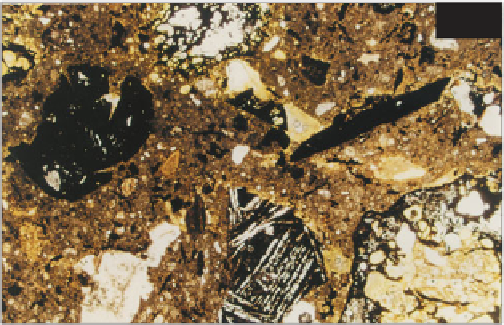Geoscience Reference
In-Depth Information
main types of grading for coarse aggregates are
continuous, single-size, and gap-graded. Fine aggregate
gradings can be described using the chart in Figure
130
.
Aggregate shape and surface texture affect concrete mix
workability and adhesion of the cement paste
respectively. Aggregate particle shape and surface texture
may be classified using a standard chart such as in Figure
133
. Additional terms for describing surface texture
include glassy, smooth, granular, rough, crystalline,
honeycombed, and porous.
The petrographer should identify the presence and
quantity of undesirable or deleterious aggregate
constituents including porous particles, flaky particles,
shell, excessive fines, mica, organic matter, sulfate and
sulfide-bearing particles, and potentially alkali-reactive
constituents. The effects of many of these constituents will
be discussed in subsequent sections and further
information regarding aggregates is provided in Chapter 4.
depending on the composition of the raw materials, their
relative proportions, and the heating/cooling regime. The
fineness of the cement can also be varied to provide
different rates of hardening and strength gain. Both 'pure'
and 'composite' varieties of Portland cement are available.
The main 'pure' varieties are normal Portland, sulfate-
resisting, and white Portland cement. In 'composite'
cements a proportion of the Portland cement clinker is
replaced by industrial byproducts such as a blastfurnace
slag, fly ash, natural pozzolana, or limestone.
In Europe, Portland cements are specified in
accordance with EN 197-1 (British Standards Institution,
2000a) and a summary of this classification is shown in
Table 17
(overleaf). In America, Portland cements are
specified using ASTM C150 (ASTM International, 2007)
and composite (blended) cements using ASTM C595
(ASTM International, 2008b), as summarized in
Table 18
(overleaf).
In terms of composition, Portland cement clinker is
dominated by four main phases, these being tricalcium
silicate (C
3
S), dicalcium silicate (C
2
S), tricalcium
aluminate (C
3
A), and tetracalcium aluminoferrite (C
4
AF).
Their microscopical properties are summarized in
Table
19
(overleaf). These clinker phases are hydraulic and on
mixing with water they react to form a range of hydrated
phases called calcium silicate hydrate gels (C-S-H), which
are largely responsible for the binding action of the
cement in concrete. Accounts of the hydration reactions
P
ORTLAND
-
TYPE CEMENTS
Portland cement is the predominant type of binder used
in concrete. Portland cement is manufactured by heating
limestone and aluminosilicate rock (such as clay or shale)
in a rotary kiln at temperatures of up to 1500°C. This
produces cement 'clinker' which is interground with
around 5% gypsum (which acts as an early set retarder)
to give the cement product.
Various types of Portland cement can be produced
161
161
Filler joist floor concrete containing boiler clinker
aggregate (black) including vesicular and glassy forms
and some residual furnace fuel (black, left). The
cement matrix is shown brown; PPT, ×35.




